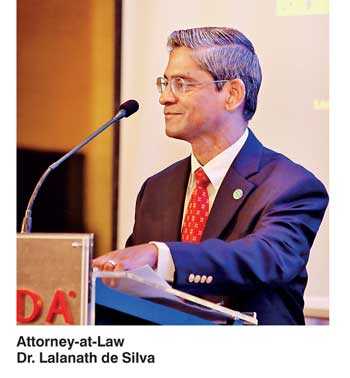Thursday Dec 12, 2024
Thursday Dec 12, 2024
Thursday, 4 October 2018 00:00 - - {{hitsCtrl.values.hits}}

Delivering the keynote address on ‘Climate Change Challenges and Solutions for Sri Lankan Businesses’ at Biodiversity Sri Lanka’s annual CEO Forum, Attorney-at-Law Dr. Lalanath de Silva stated that over the past 20 years, climate change had risen to the top as the major issue facing humanity, and yet the phenomenon was mired in seemingly endless debates.
He further emphasised that Sri Lanka had seen a historical increase, in both the number and intensity of climate calamities, such as droughts, floods, geographic changes to vector borne diseases, coastal erosion, tropical storms, crop failures, landslides and siltation of reservoirs. All of these are related, at least partially, to temperature and rainfall changes caused by climate change and have devastating impacts not only on individual species and ecosystems but also to humans and businesses.
The Annual CEO Forum of Biodiversity Sri Lanka held recently witnessed a large audience representing member companies, government officials, invited INGOs, NGOs and foreign missions, technical experts, students and academia.
Dr. de Silva quoting from a report by the Asian Development Bank, stated that tropical and subtropical regions of Bangladesh, Bhutan, India, and Sri Lanka were projected to be vulnerable to increasing temperatures and CO2 levels, with a decline in rice yields of as much as 23% by 2080. He said, a June 2017 World Bank report stated that on average over the long term, annual losses for housing, infrastructure, agriculture, and relief from natural disasters were estimated at Rs. 50 billion (or around $ 327 million), with the highest annual expected losses from floods (Rs. 32 billion), cyclones or high winds (Rs. 11 billion), droughts (Rs. 5.2 billion) and landslides (Rs. 1.8 billion). This is equivalent to 0.4% of GDP or 2.1% of government expenditure.
To overcome these challenges the report suggests that Sri Lanka needs to identify current climate risks, and implement immediate risk mitigation interventions, identify future drivers of risk and create basin-level long-term risk mitigation investment plans, followed by physical investments.
Laying out a road map for Sri Lankan businesses for adapting to the challenges and consequences of climate change, Dr. de Silva noted 10 points for consideration. They were: